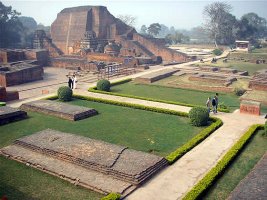NâìANDâ

Nàëandà was a small village 11 kilometres north of Ràjagaha on the main road to Patna. The Buddha passed through or sometimes stayed at Nàëandà and delivered several important discourses there. One of his disciples, Kevaóóha, described the place as `rich, prosperous, filled with people, crowded with those devoted to the Lord' (D.I,211). During the early Gupta period (4th century CE) a monastery was built at Nàëandà which gradually evolved into a monastic university and became the premier seat of Buddhist learning in India. Much of what we know of this university is derived from the accounts of Chinese monks who came to study there. At its height during the 7th century there were 8,500 students and 1,510 teachers. Students are known to have come from all over India and also from China, Korea, Tibet, Sri Lanka and Java. The curriculum included early Buddhism, Mahàyàna, Hindu philosophy and secular subjects like grammar, prosody, logic and rhetoric. There were three large libraries housing books from different countries and in a variety of languages.
When Nàëandà was sacked and burned by Muslim invaders in 1193 it had already been in decline for several centuries. Today, the ruins of Nàëandà cover a huge area and are a popular destination with pilgrims and tourists. A nearby museum displays many of the sculptures that once graced the university's halls.